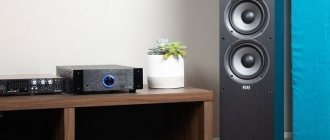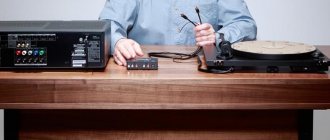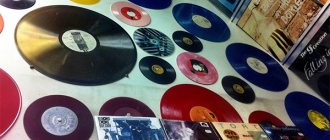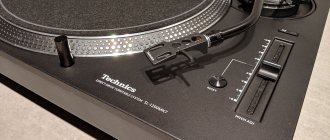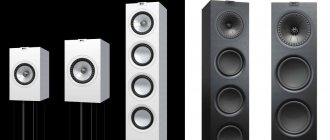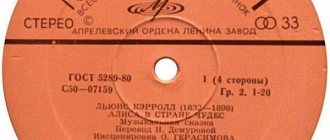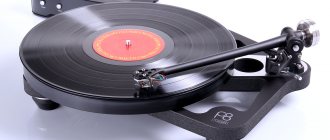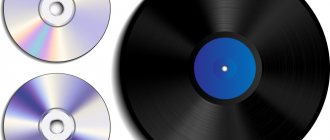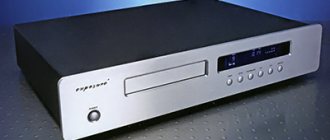Everything you need to know about turntables.
Save and read later -
The vinyl player can become the star of any system. The amplifier can be called its heart, and the speakers its face, but it is the source that turns out to be what it was originally created for. It dictates the way you consume music, and there is no other component you interact with as often as the player.
This consideration puts serious pressure on the future owner when choosing a suitable model; Looking at the vast range of options, you begin to dream that a friendly hand will quickly guide you through this process. In compiling this review, we sought to become such a mentor for you.
We'll cover how to set a budget and what factors you'll need to consider, what your options are in terms of functionality, and how to set up your turntable to get the best sound.
So, if you're thinking about buying your first turntable, or have decided to upgrade your current one to something more interesting, read on for our complete buying guide for this system component.
What it is
A vinyl record player is a device that converts the uneven tracks of a record into sound signals. Despite the common misconception, the VP has nothing in common with the gramophone or gramophone, except for the principle of reproduction. New player models are part of an audio system that includes many components.
There are all-inclusive devices called “combines” with a built-in amplifier, speakers and all the necessary connectors. But they are not perceived in a professional environment because of their poor sound. A full-fledged vinyl player must have high-quality components, including an amplifier, phono stage and speakers.
The first sound recording and sound reproducing devices
The phonautograph is considered a distant ancestor of future players. The invention of the Parisian book publisher Edouard Leon Scott de Martinville was presented in 1857 and became the world's first registered sound recording device, which recorded sound vibrations on smoked paper, but could not reproduce them.
In 1877, American entrepreneur Thomas Edison came to the editorial office of Scientific American magazine with an unknown device. After some manipulation, the device “spoke.” Edison demonstrated the principle of operation and mechanics of the phonograph. The design consisted of two membranes connected to a needle - one was used for recording, the second for playback. When sound entered the horn, the sound waves caused the diaphragm and stylus to vibrate. It deformed the surface of the tin foil that was wrapped around the replacement metal roller, leaving grooves of varying depths proportional to the volume of the sound. During playback, the needle moved along the groove, transmitting vibrations to the membrane, which emitted a signal.
Subsequently, the device and sound carriers underwent numerous improvements. In 1886, Alexander Bell and Charles Tainter patented the graphophone. Instead of foil, the rollers for it were coated with a thin layer of paraffin, which more clearly conveyed the human voice and had better wear resistance.
Player design
In addition to the components, it is important to understand the design of the device. Here are the main parts of the record player body:
- A faceplate (also called a disk or a pancake) is a special platform on which a vinyl record is placed.
- The tonearm is the part of the device on which a special cartridge with a reading needle is attached. The design of the device includes a special ring that allows you to adjust the height of the tonearm.
- A counterweight is a small weight that allows the user to adjust the force of pressure of the needle on the record.
- Anti-skating – adjustment of the anti-skating force compensator.
- The cartridge (the main part of the pickup (head)) is the most important component of the player, responsible for reading and converting the unevenness of the tracks into a sound signal.
Premium devices are traditionally assembled by hand. The base with the pancake is sold separately, the tonearm is sold separately, the head and phono stage are sold separately. The main advantage of such “composite” models is the possibility of upgrading in the future. You can always replace an outdated part with a better one. In budget vinyl players, the tonearm is not removable.
Equipment options
The base is a housing with a disk for records. The pickup and tonearm are not included and must be purchased separately. This option is relevant for high-end (Hi-End) models, since it gives the sophisticated audiophile the opportunity to assemble a player according to individual preferences. This ensures the highest sound quality.
An example of a spaced layout of an “audiophile” turntable: base + tonearm + pickup + phono stage + motor. In this case, an amplifier, acoustics (speakers), and connecting wires are purchased separately.
Disadvantages of this option: difficulty in selecting components, since it is necessary to achieve perfect compatibility between them, high cost of the finished player, possible difficulties in installation, large dimensions of the assembled system.
A base and tonearm is a more common solution, allowing the owner to purchase an additional cartridge based on his own preferences. This type of equipment is equally typical for high-end and relatively cheap equipment.
Complete set (“all in one”) – all components are combined in one housing. This is the best option for most music lovers, as it eliminates the need to search for, purchase and install additional equipment. Some models are even equipped with built-in speakers. This allows for maximum compactness of the device.
The price of a complete set is much less than “audiophile” options. In such a player, all parts are compatible with each other, and the sound quality is determined by its price. In addition, most models provide for replacement of the pickup and tonearm.
The downside of these advantages is lower sound quality than that of advanced “audiophile” equipment, which is assembled from various components.
An electrophone (“suitcase player”) is a lightweight and compact option, easy to carry. An inexpensive and impressive-looking electrophone makes it possible to enjoy your favorite “vinyl” outside the apartment, for example, in a country house. But in terms of sound quality, such a player is seriously inferior to stationary models. At the same time, a good electrophone has a high cost and is rare.
How to choose a vinyl player
Using a low-quality player, you risk not only being disappointed in the sound, but also damaging expensive records. You should not buy budget devices with a built-in phono stage, amplifier and speakers, as they do not have good playback quality. When choosing, it is necessary to take into account the weight, type of needle sharpening, type of cartridge (the principle of its operation), the possibility of replacing components and the drive. Now in more detail about all the characteristics:
Case weight
A high-quality device should be heavy. Players up to 8 kilograms exist only in the budget and mid-range segments, and, as a rule, they do not sound good. The faceplate or disk on which the plate is placed has a lot of weight. But there are manufacturers who make faceplates from lightweight carbon fiber. This makes the player body a little lighter, but does not deprive it of high-quality sound.
Types of cartridges and operating principle
There are two main types of cartridges for vinyl players - ½ inch and T4P. The first type has better sound qualities and the ability to upgrade. But it has a significant drawback: not every person can set up such a player well. The second option is a little easier to use and is suitable even for a beginner. However, improving such a device in the future will be quite difficult.
There are two types of cartridge heads on the audio equipment market: MM- and MC-. Musicians and hi-fi connoisseurs prefer MC heads because... they convey sound in more detail and softly. However, they do not support changing the tip, so if the needle is damaged, you will have to replace the entire cartridge.
Sharpening the reading needle
Cheap players have a spherical stylus. Professionals and collectors prefer turntables with elliptical sharpening, but there are other, no less successful types.
Drive unit
Vinyl turntables come in straight, belt and roller types. This determines how the pancake will move while reading the record from the record. For lovers of pure sound, belt-type devices are suitable, as they provide better glide and lack of vibration. Direct players are more appreciated by DJs (special models are made for DJs) and musicians who like to scratch. Belt-type devices have the most vibrations, so they are practically not widespread on the market. But there are fans of such players too.
Budget
If you've done any research before coming to this page, you've probably come across a plethora of all-in-one suitcase turntables with temptingly low prices to match their straightforward straightforwardness. If you need exactly this form factor, be sure to check the clamping force of the cartridge: for many models it is about 10 grams, which is 4-5 times higher than the optimal level; such a clamp can seriously damage the vinyl disc.
All models of this kind that we heard sounded bad. In any case, even if you firmly decide to go with an all-in-one system, you will have to purchase at least additional speakers for it (or better still, stands for them).
If you're starting from scratch and want to build a traditional system, then in addition to the turntable, you'll need an amplifier, speaker and interconnect cables, and a phono stage (if it's not built into the turntable or amplifier).
At the same time, the cost of the player itself should not significantly exceed a quarter of the total budget. Your system will be functional in any case, even if the turntable is significantly different in class from the speakers and amplifier, but the sound quality will not be up to par. There is no point in overpaying for one device; It's better to distribute the money more evenly.
Of course, there are many options for traditional systems with fewer components that will delight you with great sound. As mentioned, a phono stage is often built into turntables and amplifiers, in which case you might consider purchasing a standalone model later when you want to upgrade the audio path. In the limit, you can limit yourself to one player and a pair of active speakers (and you won’t even need cables if both components are capable of working wirelessly).
Even if you already have the rest of the system and have a ton of cash burning a hole in your pocket, it's worth considering how well a player in your chosen price range will match the components you have.
Will the sound quality be limited by the capabilities of the amplifier or cables - in which case you will have to spend money on replacing them later - or perhaps you haven't invested enough to make the difference from your previous player clear? You can always put off the purchase for a few more months and save up more money, or make a number of less expensive changes that may have a greater impact on the sound than you expected.
Local stores can help you find specific models based on what you already have and your personal needs. But most importantly, remember that when calculating the budget for any audio system component, you should take into account not only how much money you currently have at your disposal, but also the entire system as a whole.
Which one to buy – new or used?
It is impossible to say for sure which player is more profitable - a new one or a vintage one. If to purchase a new device you need to have a budget of at least 40 thousand rubles (the price for some models can reach up to 1,500,000 rubles), then 20 thousand will be enough to purchase a used device. But the main problem is the wear of components and the integrity of the device in principle. Buying a used turntable is always a matter of luck. Even among the old USSR devices you can find something worthwhile.
Why vinyl sounds better
The high-quality sound of vinyl, which audiophiles and professional musicians talk about, is due to the peculiarities of audio signal conversion. Unlike other modern players, vinyl has an analog sound rather than a digital one. This doesn't make it any better from a professional point of view, since a digital signal is a more accurate representation of the recording than an analogue one. However, it is precisely this “inaccuracy” that provides the records with a more “live” and cozy sound.
Listening to vinyl is not just an attempt to remember the past and be a little nostalgic. This is an opportunity to expand your horizons and take a break from the usual digital sound. Records are worth attention just as much as discs or digital recordings are worth attention.
Functions
Counterweight adjustment – allows you to adjust the tracking force by balancing the tonearm. The counterweight is located on the tonearm (opposite the pickup). A similar function is necessary when using a player with a foreign cartridge - it helps to configure the tonearm for a specific cartridge model.
Anti-skating - prevents the skating effect, which degrades sound quality and unevenly wears the grooves of a vinyl disc. The function is relevant for players with a rotating tonearm. The cheapest models often lack anti-skating.
Autoplay - automatically plays the record, which eliminates the need for the user to manually move the tonearm (you just need to press a special button). This option is especially useful for beginners, who often scratch records by carelessly lowering the needle. At the same time, autoplay increases the price of the player and can degrade the sound quality.
Autoplay and a number of other automatic functions assume the presence of a non-removable tonearm, which does not allow it to be replaced. In “audiophile” models, all operations are done manually.
Auto-Stop – Automatically raises the tonearm when the vinyl disc has finished playing. As a result, needle wear is reduced.
Reverse – allows you to play a record backwards. Reverse is useful for DJs to achieve different acoustic effects.
Recording to external digital media – allows you to record playable music in digital format onto a USB flash drive. This recording is faster than digitizing using a computer. The disadvantage is that the music is recorded with all the distortions during playback.
The ability to install a second tonearm is useful if the user needs to work with two pickups that have different characteristics (including different speeds - 33 and 78 rpm). Thus, a music lover can easily replace the pickup.
The speed is 78 rpm – typical for “gramophone” records. Accordingly, a similar option is required for listening to retro recordings. Only available on direct drive models.
Important: remember that to play vintage vinyl, you need a special pickup.
Switching speeds – makes it possible to change the speed of rotation of the faceplate. There are two types:
- mechanical - carried out manually (throwing the belt onto another pulley) and is found in models with a belt drive;
- electronic - done by pressing a button, which is much more convenient than mechanical. Electronic (automatic) switching is most common.
Tone adjustment – allows you to change the tone of the sound (higher / lower by a specified interval). This option will be needed by DJs mixing musical compositions recorded in different keys.
